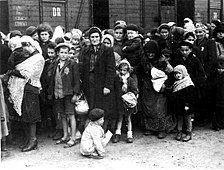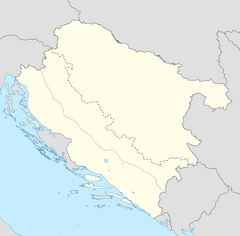
Back معسكر اعتقال ياسينوفاتس Arabic Ясеновац (концлагер) Bulgarian Koncentracijski logor Jasenovac BS Camp de concentració de Jasenovac Catalan Koncentrační tábor Jasenovac Czech Jasenovac koncentrationslejr Danish KZ Jasenovac German Στρατόπεδο συγκέντρωσης του Γιασένοβατς Greek Campo de concentración de Jasenovac Spanish اردوگاه کار اجباری یاسنواتس Persian
| Jasenovac concentration camp | |
|---|---|
| Concentration and extermination camp | |
 Arriving prisoners being robbed by Ustaše guards | |
| Other names | Logor Jasenovac / Логор Јасеновац, pronounced [lôːgor jasěnoʋat͡s] |
| Location | Jasenovac, Independent State of Croatia |
| Operated by | Ustaše Supervisory Service (UNS) |
| First built | August 1941 |
| Operational | August 1941 – 21 April 1945 |
| Inmates | Mainly Serbs, Roma, and Jews; also Croat and Bosnian Muslim political dissidents |
| Killed | 77,000–100,000[1][2][3] consisting of:[2] Serbs 45,000–52,000 Roma 15,000–27,000 Jews 12,000–20,000 Croats and Bosnian Muslims 5,000–12,000 |
| Liberated by | Yugoslav Partisans |
| Notable inmates | List of prisoners of Jasenovac |
| Website | jusp-jasenovac |
| Part of a series on |
| The Holocaust |
|---|
 |
Jasenovac (pronounced [jasěnoʋat͡s])[4] was a concentration and extermination camp established in the village of the same name by the authorities of the Independent State of Croatia (NDH) in occupied Yugoslavia during World War II. The concentration camp, one of the ten largest in Europe, was established and operated by the governing Ustaše regime, Europe's only Nazi collaborationist regime that operated its own extermination camps, for Serbs, Romani, Jews, and political dissidents.[5] It quickly grew into the third largest concentration camp in Europe.[6]
The camp was established in August 1941, in marshland at the confluence of the Sava and Una rivers near the village of Jasenovac, and was dismantled in April 1945. It was "notorious for its barbaric practices and the large number of victims".[7] Unlike German Nazi-run camps, Jasenovac lacked the infrastructure for mass murder on an industrial scale, such as gas chambers. Instead, it "specialized in one-on-one violence of a particularly brutal kind",[8] and prisoners were primarily murdered with the use of knives, hammers, and axes, or shot.[9]
In Jasenovac, the majority of victims were Serbs (as part of the genocide of the Serbs); others were Romani (the Porajmos), Jews (The Holocaust), and socialists. Jasenovac was a complex of five subcamps[10] spread over 210 km2 (81 sq mi) on both banks of the Sava and Una rivers. The largest camp was the "Brickworks" camp at Jasenovac, about 100 km (62 mi) southeast of Zagreb. The overall complex included the Stara Gradiška sub-camp, the killing grounds across the Sava river at Gradina Donja, five work farms, and the Uštica Roma camp.[1]
There has been much debate and controversy regarding the number of victims killed at the Jasenovac concentration camp complex during its more than three-and-a-half years of operation. Over the last few decades, a consensus has formed in support of estimates of the Ustaše regime having murdered somewhere near 100,000 people in Jasenovac between 1941 and 1945.[2][11][12][13][14][15][16][17]
- ^ a b Jasenovac Memorial Site.
- ^ a b c USHMM.
- ^ Kolstø 2011, pp. 226–241.
- ^ Logos, Aleksandar A. "Jasenovac in Croatia or a short story about a war and mass killing in it". p. 28 with footnote 86. In Croatian and Serbian language word "jasen" means ash tree and the name Jasenovac means "ashen, or made of ash tree". Retrieved 2022-09-28.
- ^ Radonić 2009, p. 179.
- ^ McCormick 2014, p. 77.
- ^ Tomasevich 2001, p. 399.
- ^ Crowe 2013, p. 71.
- ^ Freund 2016.
- ^ Breitman 2005, p. 204.
- ^ Pavlowitch 2008, p. 34.
- ^ Higham 2001.
- ^ Hawton & Kovac 2005.
- ^ Dulić 2005.
- ^ Stone 2013.
- ^ Bartrop & Dickerman 2017.
- ^ Mikaberidze 2018.
© MMXXIII Rich X Search. We shall prevail. All rights reserved. Rich X Search
